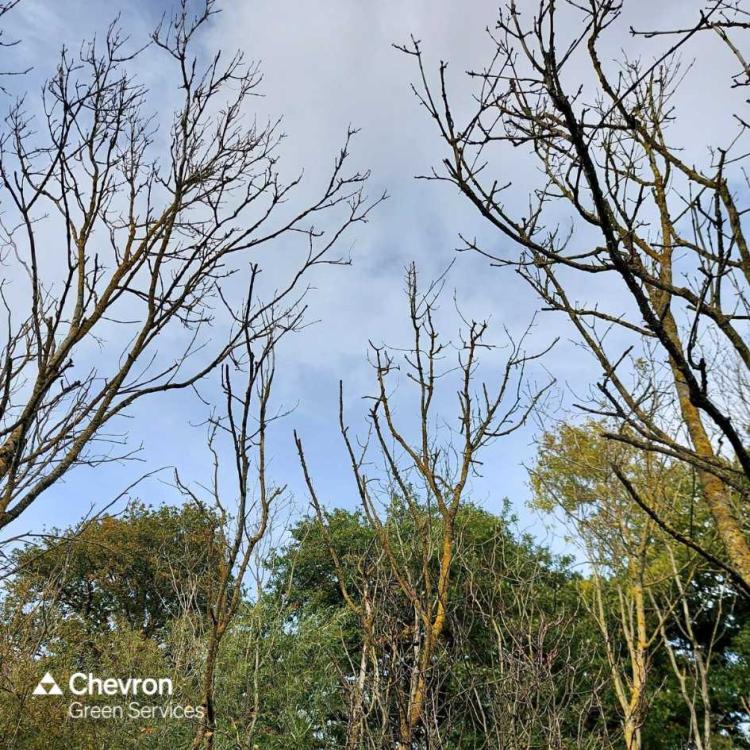
Where and when did ash dieback originate?
The ash tree has always been a part of our landscape and makes up around 15% of the total woodland cover in the UK. It is now well under threat from the fungal disease called ash dieback. The disease was native to eastern Asia and was first officially identified in the UK in the southeast of England in 2012.
It has now spread across the whole of the UK having huge impacts on our ash trees which could lead to the destruction of our ash woodlands over the next 20 to 30 years. Ash dieback has caused widespread damage across mainland Europe because European Ash didn’t evolve with the dieback fungus and therefore has no natural defence against it.
What does ash dieback look like and how does it impact our ash trees?
The disease displays across 4 different classes and stages of decline. Ash dieback can be and is often fatal to trees. The ash dieback fungus lies dormant in winter and produces fruiting bodies July to October which release spores. Spores can be carried by the wind, when blown onto leaves they can penetrate the leaf. Then it spreads into the tree growing inside it which results in it blocking the tree water transports systems causing the tree to fail and die. Although the tree may initially be able to defend itself, it will likely succumb to repeat infections.
The impacts of ash dieback can be seen on trees of all ages, although younger trees succumb to the disease faster, with mature ash trees having a much slower rate of decline over a several year period.
The signs to look out for include:
- Leaves develop dark patches in the summer.
- They then wilt and turn to black. Leaves may shed early.
- Dieback of the shoots, leaves, and branches.
- Lesions develop where branches meet the trunk. These are often diamond shaped.
- Epicormic growth from the branches and trunk which is common for trees under stress.
- Canopy dieback as the infection develops.
- Wood becomes very brittle.
On a positive note, over the last year, our Arboricultural Consultants and Surveyors have seen a slight improvement in the health of some infected ash trees. Most likely this is due to environmental factors, as we have had several droughts in recent years causing additional stresses. In 2023 we had one of the wettest summers on record which has contributed to the slight increase in their vigour and overall health.
The impact of ash dieback in the UK
Unfortunately, the impact of ash dieback on native ash trees is predicted to be severe losing significant ash populations nationwide. This will have devastating consequences for biodiversity of wooded areas, a major loss in the connectivity between habitats and a potential loss in air purification and carbon storage services that trees provide. Many trees have already had to be felled, as once the tree is infected by the disease it becomes very brittle and can drop limbs, collapse, or fall, which can be hazardous if it is in an area near people or property, such as housing, roads or railways. The management of ash dieback is therefore predicted to be high due to the logistics and practical expense of clearing the dead and dying ash trees.
The good news is that there have been findings of some ash trees showing signs of natural resistance which is under ongoing research to develop resistant strains of ash species so who knows what the future holds for our ash trees and the UK landscape.
Ash trees and Emerald Ash Borer
There’s also another biosecurity threat to our ash trees and the UK is currently on high alert. The Emerald Ash Borer is a beetle that’s only known hosts are ash trees which would be another blow to our native species.
The emerald ash borer kills the tree throughout its life cycle as the female lays its eggs within the tree bark, when the eggs hatch the larvae start feeding and tunnelling through the sapwood, feeding on the nutrients that the tree is taking up from the roots. As the larvae get bigger, so do the tunnels, essentially girdling the tree causing it to starve and lead to mortality.
The signs and symptoms will be very similar to the signs of ash dieback in the early stages regarding the wilt and crown dieback, but the tree will have boreholes in the bark when the adult beetle has emerged to start the cycle all over again.
The Emerald Ash Borer has not currently made its way to the UK but has had devastating effects in the US and if it manages to get over here, it may be the end of our ash trees that are already under immense threat.
What can we do?
Unfortunately, there are limited options but something we can do is ensure good practice of biosecurity to manage the spread of any disease. Washing your footwear both before and after entering a wooded area, washing vehicle tyres, and sticking to footpaths can all help reduce the spread of spores.
How can Chevron Green Services help?
If you’re worried about any trees on your land and would like a condition survey to check for ash dieback or other potential concerns, please contact our Consultancy teams at: Consultancy@ChevronGS.com



















